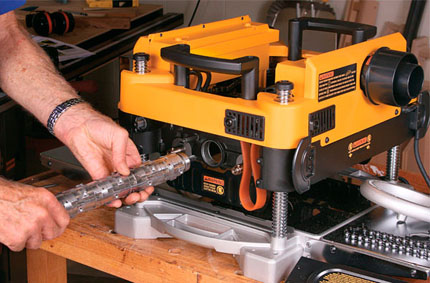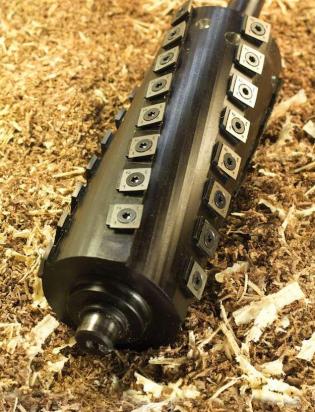Are you wondering if helical planers are better than their traditional counterparts? Well, buckle up and get ready to find out! In this article, we’ll delve into the world of woodworking and explore the benefits of using helical planers. So, whether you’re a DIY enthusiast or a professional woodworker, this is the ultimate guide for you!
If you’re new to woodworking, you might be wondering, “What exactly is a helical planer?” Great question! A helical planer is a specialized tool used to smoothen and flatten wood surfaces. It features a rotating cutterhead with multiple small, square-shaped cutting inserts arranged in a helical pattern. This design offers several advantages over traditional planers, which often have straight knives.
Now, here comes the exciting part – the advantages of helical planers! These handy tools provide superior cutting performance, reduced tear-out, quieter operation, and longer tool life. Plus, they allow for easier knife replacement and require less power to operate. So, if you’re looking to elevate your woodworking game, a helical planer might just be the game-changer you need.
So, are helical planers better? Absolutely! From improved cutting performance to reduced tear-out, these nifty tools offer a host of benefits that can take your woodworking projects to the next level. Whether you’re smoothing rough lumber or creating intricate designs, a helical planer is a must-have tool in any woodworker’s arsenal. Get ready to experience woodworking like never before with the power of helical planers!

Are Helical Planers Better? A Comprehensive Analysis
Helical planers are a popular choice among woodworkers and carpenters. They offer several advantages over traditional planers, but are they truly better? In this article, we will delve deep into the world of helical planers and explore their benefits, drawbacks, and how they compare to other types of planers. Whether you’re a professional or a hobbyist, this article will provide you with the information you need to make an informed decision about whether helical planers are the right choice for your woodworking projects.
The Technology Behind Helical Planers
Understanding the technology behind helical planers is crucial to determining their superiority. Unlike traditional planers that use straight blades, helical planers feature spiral cutterheads with multiple small, individual cutting edges. This design significantly reduces noise, minimizes tear-out, and produces smoother finishes. Additionally, the helical cutterheads are easier to maintain and replace, giving them a longer lifespan compared to their straight-blade counterparts.
The Benefits of Helical Planers
Helical planers offer several key benefits that make them a favorite among woodworking enthusiasts:
- Reduced tear-out: The spiral cutterheads of helical planers slice through wood fibers more efficiently, resulting in minimal tear-out or splintering. This is especially advantageous when working with fragile or figured wood that is prone to tear-out.
- Less noise: The helical design of the planer’s cutterhead reduces noise levels, making it more comfortable to work with for extended periods.
- Smooth finish: The multiple cutting edges on the helical cutterhead produce finer shavings and a smoother surface finish, eliminating the need for additional sanding or finishing.
- Easy maintenance: Unlike traditional planers that require sharpening and alignment of multiple blades, helical planers feature individual carbide inserts that can be quickly replaced when worn out.
These benefits make helical planers a valuable tool for both professionals and hobbyists, enhancing the overall woodworking experience and the quality of the final product.
Helical Planers vs. Traditional Planers
It’s important to compare helical planers with their traditional counterparts to determine their superiority. While traditional planers are tried and tested tools, helical planers offer several advantages:
- Reduced tear-out: Traditional planers with straight blades are more prone to tear-out, especially with difficult woods. Helical planers with their spiral cutterheads provide a much cleaner and tear-out-free finish.
- Improved durability: The individual carbide inserts on the helical cutterhead can be replaced as needed, extending the lifespan of the tool compared to traditional planers that require constant sharpening.
- Enhanced noise reduction: Helical planers are considerably quieter than their traditional counterparts, which contributes to a more comfortable and less distracting work environment.
- Increased versatility: Helical planers can handle a wider range of wood species, including figured wood, thanks to their reduced tear-out and improved cutting efficiency.
Overall, helical planers offer significant advantages over traditional planers, making them a better choice for many woodworkers.
Tips for Using Helical Planers
- Take lighter passes: Helical planers excel at taking shallow cuts, so it’s best to avoid deep cuts to maintain optimum performance and surface quality.
- Check and replace inserts regularly: Keep a close eye on the condition of the carbide inserts and replace them promptly when they become dull. This will ensure consistent and efficient cutting.
- Consider investing in a dust collection system: Helical planers can generate a significant amount of shavings, so investing in a dust collection system will keep your workspace clean and maintain optimum performance.
Are Helical Planers Better? The Verdict
After a thorough analysis, it is evident that helical planers offer numerous advantages over traditional planers. The reduced tear-out, smoother finish, ease of maintenance, and improved durability make them a better choice for most woodworking projects. However, it’s essential to consider your specific needs and budget when making a decision. Ultimately, the choice between a helical planer and a traditional planer depends on the preferences and requirements of the user. With the information provided in this article, you are now equipped to make an informed decision that suits your woodworking needs.
Choosing the Right Helical Planer for Your Woodworking Projects
Now that we have established the superiority of helical planers over traditional planers, it’s time to delve into the different options available and help you choose the right helical planer for your woodworking projects.
Factors to Consider When Choosing a Helical Planer
When selecting a helical planer, consider the following factors:
- Size and capacity: Determine the size and capacity you require based on the size of your projects and the type of wood you frequently work with.
- Build quality: Look for a planer with a strong and durable construction to ensure it withstands rigorous use.
- Motor power: Consider the power of the motor to ensure it can handle the type and thickness of wood you typically work with.
- Price: Set a budget and choose a helical planer that offers the best value for money without compromising on quality.
Top Helical Planer Brands
Here are some renowned brands that offer high-quality helical planers:
- DeWalt: DeWalt is known for its reliable and durable power tools, and their helical planers are no exception.
- JET: JET offers a range of helical planers with excellent build quality and performance, catering to both professional and hobbyist woodworkers.
- Powermatic: Powermatic helical planers are known for their precision, durability, and ease of use, making them a favorite among woodworking professionals.
By considering these factors and exploring reputable brands, you can find the perfect helical planer that meets your woodworking requirements and delivers exceptional results.
Key Takeaways: Are Helical Planers Better?
- Helical planers have spiral-cutting heads instead of traditional straight blades.
- They offer smoother and quieter operation compared to conventional planers.
- Helical planers produce superior finishes with reduced tear-out on wood surfaces.
- They are more efficient in handling difficult grains and figured woods.
- Helical planers may have a higher upfront cost, but they provide long-term benefits and durability.
Frequently Asked Questions
In this section, we’ll address some common questions related to helical planers and whether they offer any advantages over conventional planers.
1. How does a helical planer differ from a conventional planer?
A helical planer is similar to a conventional planer in its function of smoothing and leveling wood surfaces. However, what sets it apart is the cutting mechanism. While a conventional planer has a single, straight blade, a helical planer features multiple small cutting blades arranged in a helical pattern on a rotating cutterhead.
This helical arrangement allows for a smoother and quieter cutting action as well as reduced tear-out on difficult wood grains. Additionally, because the blades are staggered, there is less strain on the motor when planing, resulting in a longer tool life and less maintenance.
2. Are helical planers suitable for all woodworking projects?
Helical planers are well-suited for a wide range of woodworking projects. Their ability to handle difficult wood grains with reduced tear-out makes them a popular choice for planing figured woods, knotty timbers, and high-density materials like hardwood and exotic woods.
Whether you’re working on cabinets, furniture, flooring, or any other woodworking project, a helical planer can deliver smooth and professional results. However, it’s important to note that helical planers may not be suitable for heavy material removal or extremely large stock due to their smaller cutting blades.
3. Do helical planers require more maintenance compared to conventional planers?
Contrary to what one might expect, helical planers generally require less maintenance compared to conventional planers. The helical cutting arrangement results in less strain on the blades, leading to longer blade life and fewer replacements. Additionally, since the blades are smaller, they can often be resharpened instead of replaced, saving both time and money.
However, it’s still important to perform routine maintenance tasks like cleaning and lubricating the planer to ensure optimal performance. Regular checks for any loose screws or misaligned blades are also recommended to maintain accuracy and prevent any potential issues.
4. Can a helical planer prevent tear-out on difficult wood grains?
Yes, one of the key advantages of using a helical planer is its ability to reduce tear-out on difficult wood grains. The helical arrangement allows the cutting blades to engage the wood fibers more gradually, minimizing tear-out that is often encountered when using conventional planers.
This characteristic makes helical planers particularly useful when working with figured woods, highly figured grains, or woods with interlocking fibers. By reducing tear-out, helical planers help achieve smoother finishes and minimize the amount of sanding required during the woodworking process.
5. Are helical planers more expensive than conventional planers?
Helical planers generally tend to be more expensive than conventional planers. The addition of a helical cutterhead, which includes multiple small cutting blades, increases the manufacturing cost of these planers.
However, it’s important to consider the potential benefits and long-term savings that helical planers can provide. They offer a smoother cutting action, reduced tear-out, and longer blade life, which can result in less material wastage and a higher quality finish. Ultimately, the decision whether to invest in a helical planer depends on your specific woodworking needs and budget.

Summary
Helical planers are better for woodworking because they offer smooth and efficient cutting. The spiral-shaped knives reduce noise and tear-out, resulting in high-quality finished surfaces. Helical planers are also easier to maintain and can last longer than traditional planers. They may be pricier, but the benefits make them a worthwhile investment for serious woodworkers.
Overall, helical planers provide improved performance and superior results compared to conventional planers. They are a valuable tool for achieving professional-level woodworking projects, delivering precision and reducing the need for additional sanding or finishing. If you’re serious about woodworking, a helical planer is a great addition to your workshop.
